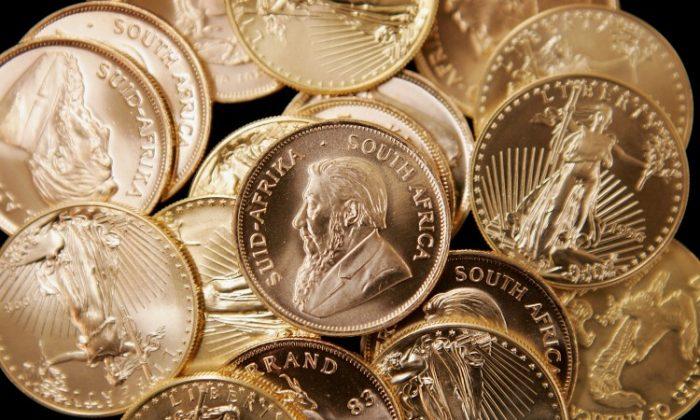The re-emergence of the gold standard is hotly debated, because many of the world’s governments have been printing too much paper money, making money worthless over time, according to economists’ and other experts’ opinions.
Gold as a standard would allow the U.S. government to assign a weight and purity. Purity could range from 100 percent to much less.
However, not all support a gold standard.
“Faced with the kind of shock we’ve just experienced, the real price of gold would ‘want’ to rise. But under a gold standard, the nominal price of gold would be fixed, so the only way that could happen would be through a fall in the general price level: deflation,” according to well-known economist Paul Krugman in the Aug. 26 edition of the New York Times.
A Sept. 11 headline on the Money Morning website suggests that “A New Gold Standard is Just a Dream—for Now.”
The world is not ready for a gold standard as the circulation of gold increases only by 0.22 percent annually, making it highly deflationary, given the growth of the global population. A second problem is that maintaining a gold standard would be exorbitantly expensive for the world’s central banks and the banking system.
“It’s pretty unlikely that the U.S. will ever re-adopt the gold standard, both because of the cost and because of the vested interests opposed to it,” according to the Money Morning article.
Advocating a Parallel Currency
A parallel currency is a second currency, which could be any kind of precious metal, such as gold and silver, or another currency, such as the Euro.
“Since gold can’t be printed, it is the only honest currency that exists. This is why many governments don’t like gold increasing in value against their paper money since it exposes their total incompetence in running their country’s economy,” according to a 2009 report on the Rapid Trends website.
In an Aug. 2 hearing held by the Subcommittee on Domestic Monetary Policy, U.S. Rep. Ron Paul argued that Americans should have the right to choose a currency, be it gold or any other commodity.
On the other hand, there are those, including a great number of economists, who believe that a gold standard would not be appropriate for current society because it would be like “trading in an automobile for a horse and buggy,” according to an Aug. 29 article on the Seeking Alpha website.
There are countries where an ordinary citizen can set up a bank account denominated in silver and can pick up said silver at any time without having to pay taxes.
In Singapore, ordinary people can set up bank accounts denominated in gold and silver. America’s super rich can store gold or silver in London’s or Singapore’s financial districts, while such transactions would be very difficult for an ordinary U.S. citizen.
Paul suggests that printing money under the quantitative easing policy to stimulate the economy could, in the end, result in hyperinflation, which would be disastrous for ordinary Americans.
“Should the United States ever face a hyperinflationary crisis, which due to the Fed’s quantitative easing is very possible, the only means of survival would be through the use of parallel currencies,” according to Paul’s testimony, published on the Committee on Financial Services website.
Legalization of Gold on Its Way
“Over the last 18 months, lawmakers from 13 U.S. states have been busy. Worried about the Federal Reserve and the U.S. dollar on the brink of collapse, they are proposing bills to recognize gold and silver as legal tender,” according to an article on the Lombardi Financial website.
In March, Gov. Gary Herbert of Utah and the South Carolina legislature each signed a bill allowing the use of gold and silver coins as legal tender. Missouri, Colorado, Montana, Idaho, Indiana, New Hampshire, and Georgia are also deliberating such bills, while there is a bill pending in Washington state that would approve gold coins as legal tender. Virginia’s legislature “passed a bill that will allow the state to mint gold, silver, and platinum coins,” according to the Lombardi Financial article.
“To have states pass laws to recognize gold and silver as legal tender may seem a bit odd since the federal government already recognizes US silver and gold bullion coins as legal tender,” an entry on the Gold Coins-Silver Bullion website suggests.
Next ...
Relationship Between Currencies and Gold
Relationship Between Currencies and Gold
“The US government (as well as most other governments) has totally destroyed the value of real money by issuing unlimited amounts of paper money and in the next few years they will also kill off the remaining 1.7% of value to make the paper dollar reach its intrinsic value of zero,” according to the Rapid Trends report.
The U.S. dollar and many other currencies have dropped 79 percent against gold since 2002. Gold mirrors the continued printing of paper money.
According to the Rapid Trends report, 103 years ago, in 1909, 50 ounces of gold cost $1,000, while currently, for the same $1,000, one receives approximately 0.83 ounces, depending on the value of 1 ounce of gold. Under this example, the dollar decreased by 98.3 percent in contrast to gold. This suggests that the value of the dollar is 1.7 percent against gold.
When compared to gold, “the problem with paper money is that governments can create unlimited amounts. ... Money printing gives them the illusion of being richer whilst all they have are pieces of paper with more zeros on them,” the Rapid Trends report states.
Generalizations About Gold
According to the Number Sleuth website, by the end of 2011, the world’s gold reserves, that is, the gold that has been mined since ancient times, amounted to 165,000 metric tons, or 5.8 billion ordinary ounces. Over 50 percent of the world’s gold has been extracted since the 1960s.
“The world’s richest deposits are fast being depleted, and new discoveries are rare. … Most of the gold left to mine exists as traces buried in remote and fragile corners of the globe,” the Number Sleuth website states, quoting a 2009 article in National Geographic.
In the 1900s, miners extracted about 441 tons annually. Extraction increased over the years, and today, about 2,756 tons are extracted annually.
According to a 2012 report from the U.S. Geological Survey, there are still approximately 56,217 tons of gold underground. A total of about 2, 976 tons were extracted during 2011 throughout the world. Therefore, it appears that only 18.89 years of in-ground gold reserves are left, unless the tons of gold extracted annually increases.
Gold has outperformed the stock market for quite a number of years, with the Dow Jones declining by 80 percent when compared to gold.
According to the Rapid Trends report, from November 1999 to November 2009, “gold in yen has appreciated by 233% whilst the Nikkei [Japanese stock market] has fallen by 46%.”
At the same time, the German DAX stock market had fallen by 2 percent while gold in Euros had appreciated by 165 percent. The FTSE in the United Kingdom has fallen by 18 percent, while gold in STG (Sterling) appreciated by 271 percent, and the S&P dropped by 21 percent, while gold in U.S. dollars appreciated by 285 percent.
The Epoch Times publishes in 35 countries and in 19 languages. Subscribe to our e-newsletter.






